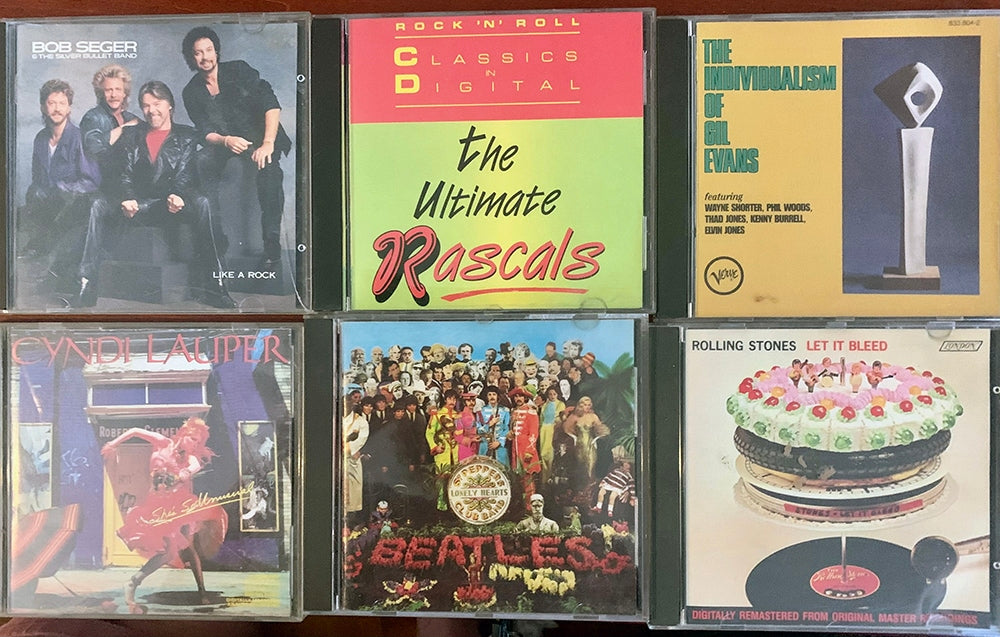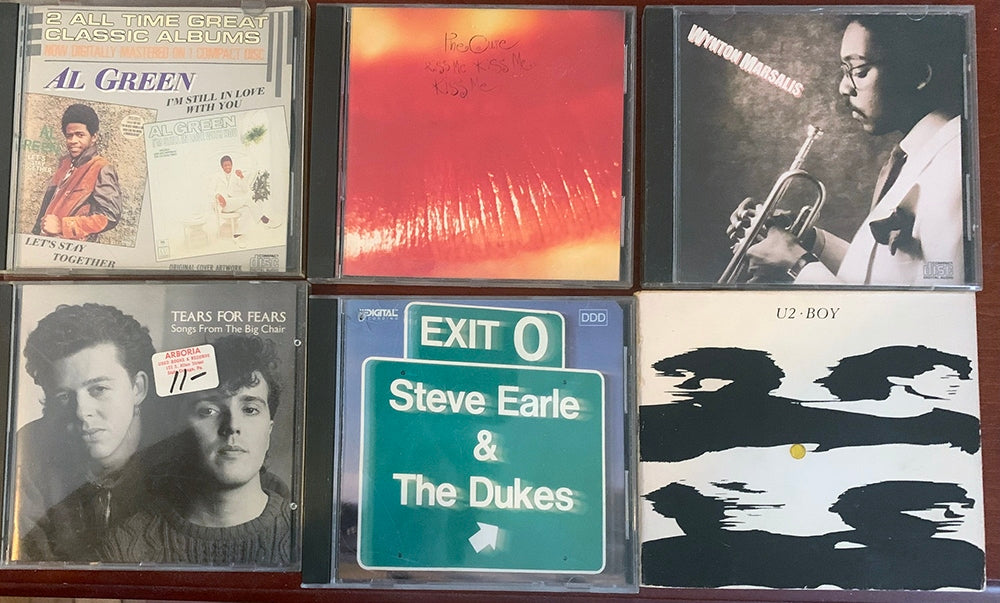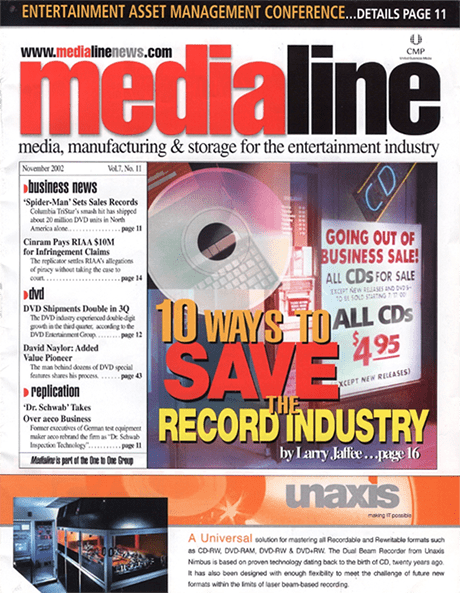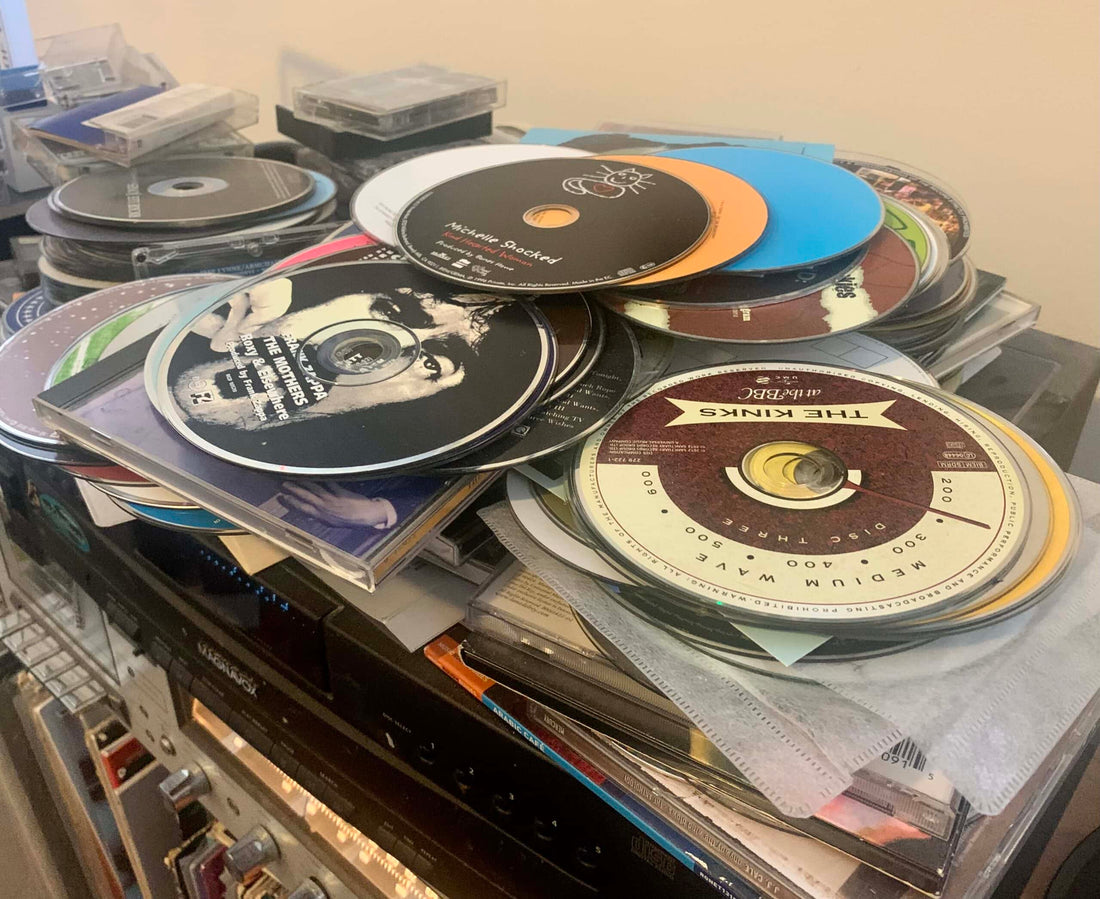File under “what comes around, goes around.” I wrote the following unpublished piece in 1986, found unexpectedly after going through old computer files. The deja vu of my music consumption patterns and the sheer irony of me now preferring vinyl makes for some interesting reading from this time capsule, especially since it’s been almost 40 years since the CD was introduced in Japan in November 1982.
In 2010, I foolishly sold 4,000 LPs, save for a hundred favorite and/or valuable autographed records. I have spent the past decade rebuilding that collection. When I purged the LPs, I also sold 3,000 CDs and kept about a thousand. I still occasionally buy CDs if I can’t find an album on vinyl. Towards the end of the article, I reference an early CD purchase of the music of Jethro Tull played by a symphony orchestra. I recently bought the album again – on vinyl, for $7.99 in its original, unopened shrink wrap (above). In hindsight, the music is much better than I remembered.
For someone who never knew how to properly take care of records (i.e., leaves them exposed out of their jackets and then wonders where the scratches came from; hasn’t even thought about buying a Discwasher), the advent of compact discs has been an amazing gift for this frequent prerecorded music purchaser.
On the other hand, CDs have presented a whole load of new problems that I’ve never had to deal with before. For example, how do I get used to plunking down $15 for an album I would previously pay no more than $7? Or, do I undertake the costly proposition of replacing numerous worn-out classics like The Dark Side of the Moon and Exile on Main St.?
And, while perusing my neighborhood record stores (an at least twice-a-week ritual), how do I resist the impulsive urge to buy that latest release that may or may not be released on CD, given the slow production that the new format has experienced?
In recent weeks, my CD addiction has become even more pronounced since there so many good releases (the Beatles series, U2’s The Joshua Tree, Simply Red’s Men & Women, and Prince’s double-disc Sign o’ the Times. I’ve found that my subscription to biweekly Rolling Stone always nagging me to buy the latest product, as well as my American Express and Visa cards, have been no help in resisting my digital urges.

A sampling of the CDs purchased in 1986 and 1987 that remain in my collection. At the time, they were albums I did not own on vinyl.
I’m even making lists of what to buy next. Well, there are the new releases by XTC, Hüsker Dü and Fleetwood Mac, and then some oldies such as the Rascals, Jackie Wilson and James Brown. What scares me most about shelling out an average of $20 a week on CDs is that I am living up to the yuppie myth that CD player owners buy three and four discs at a time. It’s hard to convince friends you’re not a Yup when you’ve got a VCR, PC, answering machine and CD player, especially when you embarrassingly admit to buying three discs at a time.
I don’t even have the time to really get into that much music during a typical work week. In comparison, I used to savor every record purchase until I was sick of it, and then buy another one. Now I find myself not wanting to pass up a hard-to-find CD because some other fanatic may beat me to the last copy and the CD may never be available again.
As I long as I can remember, buying records has always had a therapeutic effect on me when feeling low. A psychologist acquaintance offered a clinical explanation to me about my habit. “It’s called the theory of acquisition. You feel power in what you buy.” He went on to explain that it’s not really a serious condition, because I’m able to function normally and not obsessed by CDs. I should worry once it begins to seriously affect my personal finances. Two indications that it’s not real manic behavior are that I can resist the temptation, and usually only buy on-sale or heavily discounted CDs. I don’t hyperventilate, get dizzy or perspire when I enter a record store.
To fill the mental void, some people squander money on unneeded clothes or jewelry, some drink or take drugs, and others gamble. I follow the school of thought of the now-deceased rock critic Lester Bangs, who once mused on The Village Voice fashion page something like, “Who needs new clothes? I need records!” It’s too bad Lester isn’t around to enjoy the pristine sound of CDs.

I’m especially glad I hung onto these Tears for Fears, the Cure, and Al Green CDs. Labels should have done more of the 2-for-1 variety, which Motown specialized in.
Everything the media hyped about CD’s superior, sonic-boom sound is true, and I only have an inexpensive player with only adequate speakers. It took a little bit of time, but now I firmly believe that crisp recordings sans hiss are well worth the extra bucks.
I remember in my pre-CD days, when I got the Dream Academy’s debut album on vinyl, how I was excited about the group’s fresh, full sound and optimistic songs, only to loudly lament several minutes into that first playing, “what is that goddamn crackle? This is a brand-new record!”
I should point out here that I’ve never been much of an audiophile (despite being a professional music critic for the past decade), and that my $100 stereo held together by paper clips was the laughing stock of Hofstra University in the late 1970s. (After a sizable check from Rolling Stone in December 1981 for a freelance story, I was finally able to buy a respectable system with name-brand components, albeit relatively inexpensive by hi-fi standards.)

Cleaning out my parents’ house two years ago, I came across my first tape deck. My budget stereo, held together by paper clips, kept my college dorm floor amused.
Ironically, I joined the digital age by accident in November 1985, when I thought I was buying the five-record Bob Dylan Biograph collection at Tower Records’ downtown New York store for $24.99. I realized something was amiss when I opened the box to find three CD boxes instead of the five records promised on the outer package. My first reaction was to exchange the CD collection for the records for two reasons: it was the store’s mistake, and I didn’t own a CD player, which meant I couldn’t hear my latest purchase for a while. On the other hand, I had thought seriously about buying a player, but couldn’t really afford one at the time.
While I didn’t yet own a CD player, a Sony quality control error had put three CDs in a box promising five LPs, which I had recently bought on vinyl. I figured that the box must have been mispriced, knowing that the CD Dylan set was being sold by other retailers for about $40. Hence, I was getting a rare and big discount. (It seems like the folks at Columbia Records and/or Tower have made sure they didn’t make the same mistake of using the same packaging for all three formats with Springsteen’s live collection, which specifically states on the boxes, “Three Compact Discs,” or “Three Cassettes,” or “Five Records.”)

When I didn’t yet own a CD player, a Sony QC error put three CDs in a box promising five LPs of Bob Dylan’s Biograph, which I have recently bought on vinyl.
So I realized if I was serious about eventually getting a CD player, what better way than starting my collection with the best of Dylan, which I’m sure I’d want to keep for posterity later in the 21st century. Before getting into a discussion of hardware, and more on actual CD purchases, the Dylan choice is interesting to elaborate on since I have almost all of his albums, and was really attracted to Biograph for the 10 or so previously-unreleased tracks.
For my first CD purchase I had already broken my first rule: not to buy what I already owned on LP. To make matters worse, I found most of the new material to be disappointing, and understood why Dylan chose not to release it in the first place. Nevertheless, the vintage Dylan classics like the set’s opening song, “Lay Lady Lay,” featured lucid percussion that I previously hadn’t been able to hear on the record, thus already justifying the collection’s purchase.
By early January 1986 I had saved enough to plunge into the CD era. Generally, when it comes to electronics I opt for the lower-end price points, figuring that extras like remote controls are not essential. The new CD player would be joining a basically no-frills system: $150 Technics receiver; $100 Akai turntable; $75 Studio Design speakers; and a $50 Sanyo cassette deck. I was prepared to spend no more than $200 on a CD player, which, judging from newspaper ads, seemed to be the lowest price I was going to find. My choices were further limited since I was living at the time in a Pennsylvania college town that did not have many stores offering CD players for the budget-minded.
After a listening test at one store, Sony’s portable Discman seemed like a pretty good buy for $199 since it could either run alone or be connected to a receiver. But I decided against it when I realized the $40 battery pack weighed more than the unit.
With few choices left, I opted for a single-laser player by an unknown Japanese manufacturer, Symphonic, for $159. Several months later, New York discount retailers like Crazy Eddie were offering three-laser players made by Sharp for under $100.
But after a year of using my Symphonic, the company which ironically also made my first turntable that gave my college friends so many laughs, I’ve had a lot of satisfaction with the player, and wonder whether a more-expensive, name-brand unit really would sound that much better on my speakers. Let’s just hope it holds up.
Back to the discs themselves. Only two friends have also caught the CD bug, and they both live far away, which prevents me from borrowing any discs. For purchasing guidance, I regularly read the CD reviews in magazines like Digital Audio and High Fidelity, and consult several rock encyclopedias to see whether any old albums belong in my collection.
Since the age of 13 I’ve been a rock record-buying fanatic, so it’s hard to believe there are albums that I somehow missed and should have in my collection. Nevertheless, by the end of 1986, my CD collection was about 30 strong. In the next four and a half months, I bought another 20 discs. That’s a total of around $700. (During the same period, I probably spent another $200 on records.) I read somewhere that the average CD player owner buys 25 discs in his or her first year, which gave me a false sense of superiority, knowing that at least a third of my purchases have been somewhat disappointing and probably wouldn’t have been made given the chance to hear the albums before buying them.

More CDs from the author’s early collection.
Part of the disappointment goes back to price and perceived value. This became clear after shelling out $22.99 plus tax for the new Prince set, which contains nearly 70 minutes of music. But so does the new Smiths’ double-LP, Louder Than Bombs, of which I also bought the CD version on a credit card for $14.99 during that same trip to the register. Since both CDs are manufactured by Warner Bros Records, the difference in price seems to be purely a marketing decision to push product. The moguls and whiz kids know they’ll sell more of the Prince CD (which I’ve seen going for as high as $28.99), because he’s a superstar with a track record. They’re still trying to break the Smiths, a British band with a cult following in America. So they must have figured, “Let’s give the consumers a break on the Smiths but not Prince because they’re going to buy Prince anyway….”
Motown has the right idea by offering their “Two Classic Albums On One CD” series because the company is giving true value for the dollar. So far, I’ve only bought two of these collections: Al Green’s Let’s Stay Together/I’m Still In Love With You and Marvin Gaye’s What’s Going On/’Let’s Get It On. I had two of Green’s lesser-known albums, giving me a general idea of his Memphis-horn sound and Otis Redding-like vocal style. I’ve received a lot of satisfaction out of the Green CD release, but am having a harder time with the Gaye albums, which are supposedly “classics” that should be in every record collection. Before I bought the CD, I had a few great Gaye albums, but still haven’t discovered yet what makes these two so great.
The usually steep $15 prices have been offset somewhat by the increasing number of record stores offering used CDs for as low as $7.99, which I’m sure full-price, occasional-sale stores like Tower are not too happy about. Theoretically, a used CD (unlike a used record) should sound as good as a brand-new one since the audio quality is not supposed to diminish over time. And these stores even guarantee the discs. But I know of some people who will not buy used of anything. As far as CDs are concerned, they’re missing out on a good bargain.
I’ve picked quite a few good titles for $8.99 – $12 this way. These are mostly albums that I for some reason never got around to buying (e.g., Cyndi Lauper’s She’s So Unusual, U2’s Boy and War, Herbie Hancock Quartet (a double album on one CD), and the Pet Shop Boys’ Please. I felt like slapping myself in the head after discovering Prince’s Sign o’ the Times used for $18.99 a week after I bought it new. Apparently other CD buyers have been unhappy with their purchases (or gifts), since the used-disc stocks get bigger every time I visit the stores, which offer $4 – $6 trade-in credit towards other purchases.
But I’ve been burned on a few used purchases, finding myself buying albums that I never thought about getting before, such as Heart’s Greatest Hits or Bob Seger’s Like A Rock, which I picked up solely on impulse because I didn’t want to leave the store empty-handed. I didn’t feel any better to find I only liked the few tracks that I already knew from radio play.
Probably my biggest new CD disappointment has been A Classic Case: The London Symphony Orchestra Plays the Music of Jethro Tull. A long-time fan of the band, I figured the classical marriage would take Ian Anderson’s songs to new heights. While Case sounds especially clean, it tends to get a bit tenuous. Try to imagine a high school marching band playing the opening to “Aqualung.” My serious CD-buying friend forewarned me: “Don’t waste your money on that crap; buy real classical music!” He was right. On the other hand, recent releases from the Rolling Stones, Peter Gabriel, Robert Cray and Paul Simon have been absolute joys that I’m sure I enjoy even more because of the improved sound from the digital technology.

A Classic Case: The London Symphony Orchestra Plays the Music of Jethro Tull, album cover.
I also realized that getting a CD player would give me the opportunity to finally start learning about music that had been previously foreign to this rock and roller’s ears, namely jazz and classical. The only jazz album in my 1,000 or so record collection was The Chuck Mangione Quartet, and I don’t have any idea how it got there, and for classical, a set of Beethoven’s nine symphonies, which was a gift. My CD forays into jazz and classical have been more cautious than rock. Going on a few recommendations, I picked up Wynton Marsalis (his first, and Black Codes), Miles Davis (Kind of Blue and Sketches of Spain), Gil Evans (Out of the Cool and The Individualism of Gil Evans) and John Coltrane (A Love Supreme). I really like all of these a lot, except for the second Marsalis, which has been the second-best jazz CD as voted on by Digital Audio readers. Maybe in time it’ll grow on me.
One of the frustrating things about the classic jazz albums on CD is that a lot of them are short, such as the Coltrane selection (33 minutes), which, if the music wasn’t so great, I’d regard as a rip-off. It’s a shame that more record companies have not taken Motown’s lead and taken advantage of the format’s expanded programming possibilities.
As far as classical, I’m still a little overwhelmed, having only a rudimentary understanding of composers and their works. For the time being, my only real classical CD is Leonard Bernstein conducting the New York Philharmonic on Gershwin’s Rhapsody In Blue and Bernstein’s West Side Story. I knew I couldn’t go wrong with these. Not quite classical, but I’m not sure how else to classify the disc is Lost in the Stars: The Music of Kurt Weill. Knowing nothing about the German composer (other than that he wrote “Mack The Knife”), my curiosity was piqued after reading about this interesting album, which features contemporary Weill interpretations by a bunch of rock and jazz artists including Sting, Lou Reed, Tom Waits, Todd Rundgren, Marianne Faithful, and Carla Bley to name a few. My favorite track (of 20) is by the Armadillo String Quartet. The entire hour-long disc, which has become my favorite is extremely different from anything I’ve ever heard before. Perhaps only a music appreciation course will reduce my classical music anxiety, since I know I like particular composers and pieces; I just don’t know who and what they are.

Lost in the Stars: The Music of Kurt Weill, album cover.
No matter what musical genre, probably the best thing to do before buying is to borrow the album from a friend or library when possible, so you’ll know what you’re getting into. What makes CDs far more preferable to conventional records or cassette tapes, aside from the sound quality, is the ease of playing them.
The reason why CDs have finally caught on after being introduced by Sony and Philips about four years ago is that the hardware prices have come down to affordable levels. It’s my guess that CDs will follow growth patterns similar to what videocassettes and VCRs experienced. By the end of last year, there were 2.8 million CD players in American homes. In 1986, sales up were up 50 percent. This year is projected to even better on both counts. Now that US factories have begun to produce discs domestically, thus cutting import costs, it’s feasible that software prices will drop, so that regular-priced CDs go for $10 to $11 instead of $14 to $16. Polygram, CBS and other record companies have already introduced such budget-price, back-catalog titles.
Despite some predictions, CDs probably will never replace records entirely, but will coexist with vinyl. Since the advent of rock and roll, between 2,000 and 4,000 albums have been released annually. Most of them will stay out of print, let alone make it to CD. Hence, turntables will always be needed. I wonder whether other CD buyers have pondered this technological revolution as much as me.
Also, I wonder whether a CD owner talks himself or herself into liking an album because he or she is paying more for it, and therefore thinks it ought to be good. And if so, will the purchaser give the CD more repeated listenings than if on record so that the album will grow on him or her? Of course, the answer lies in an individual’s sense of aesthetics and why we like what we like: in short, in the mystery of music.

The ephemeral nature of ephemera: The November 2002 issue of Medialine, no longer published, which the author edited.
Copper contributor Larry Jaffee is author of the book Record Store Day: The Most Improbable Comeback of the 21st Century, and was editor of the CD production trade magazine Medialine from the format’s sales peak in 1998 until 2005. He is the co-founder of industry trade organization Making Vinyl. More information is available at www.larryjaffee.com.



